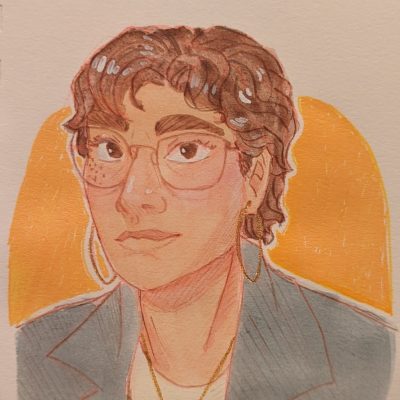From Space, to Earth, and Back Again
Isabel Lopez and Scott Fisher
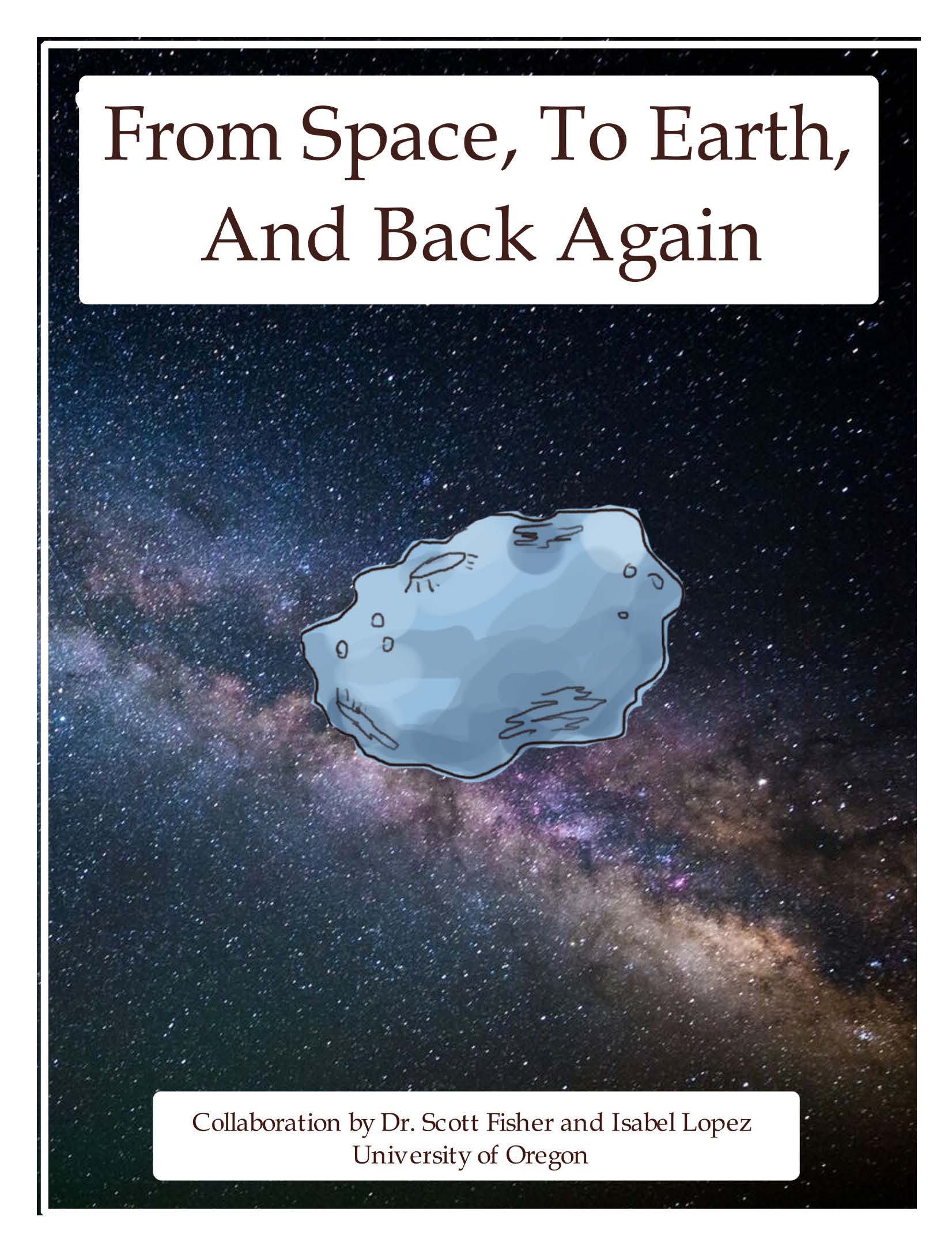
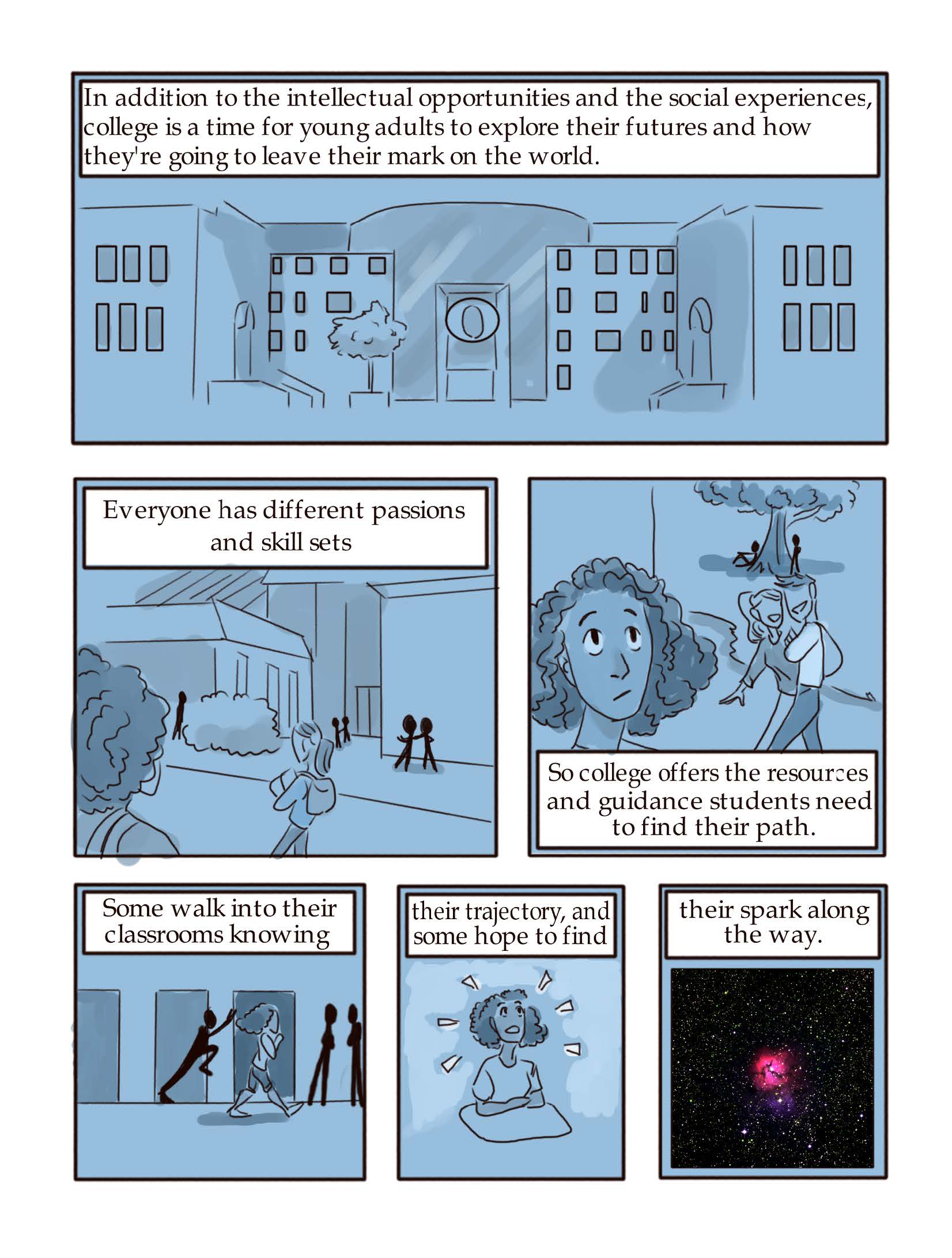

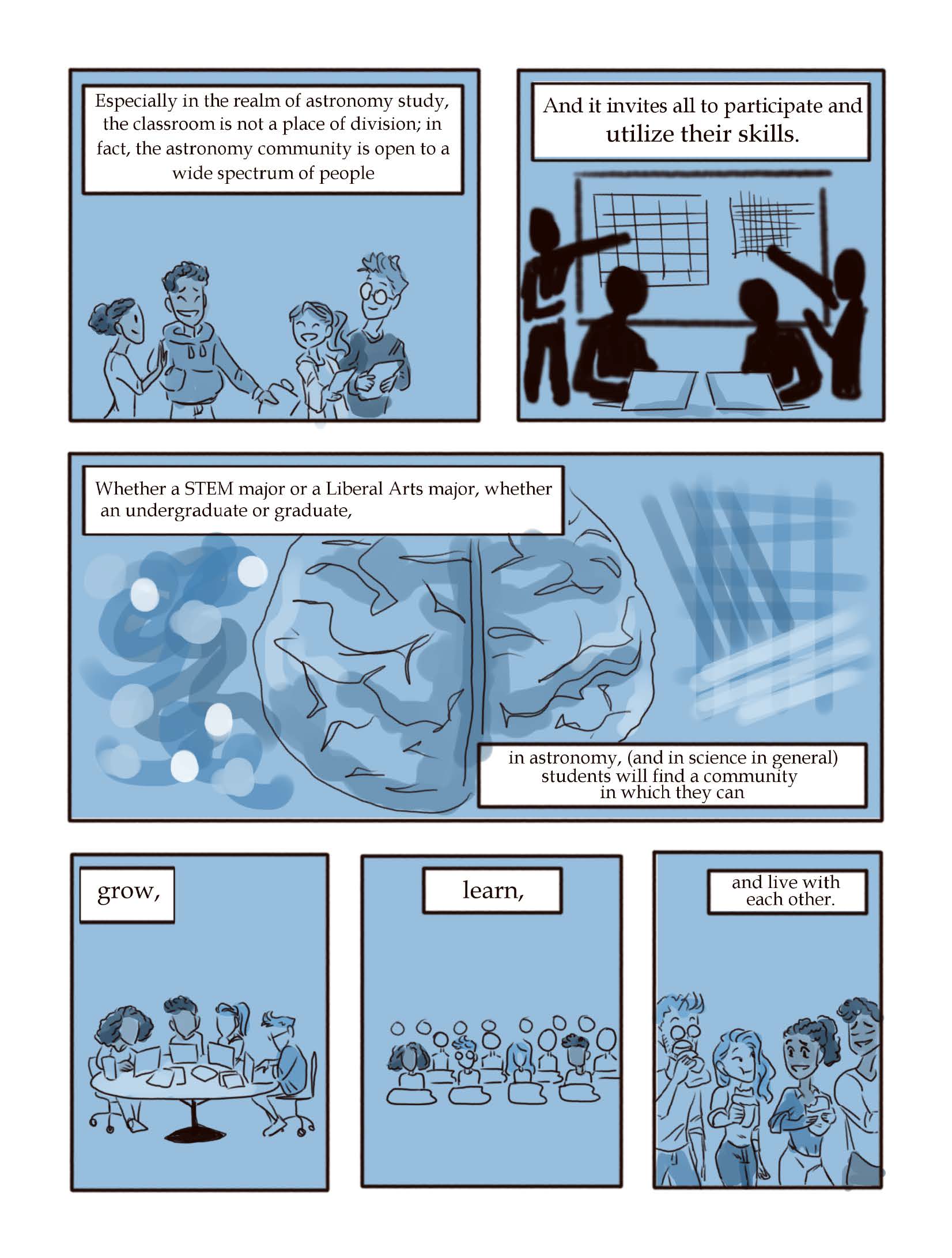
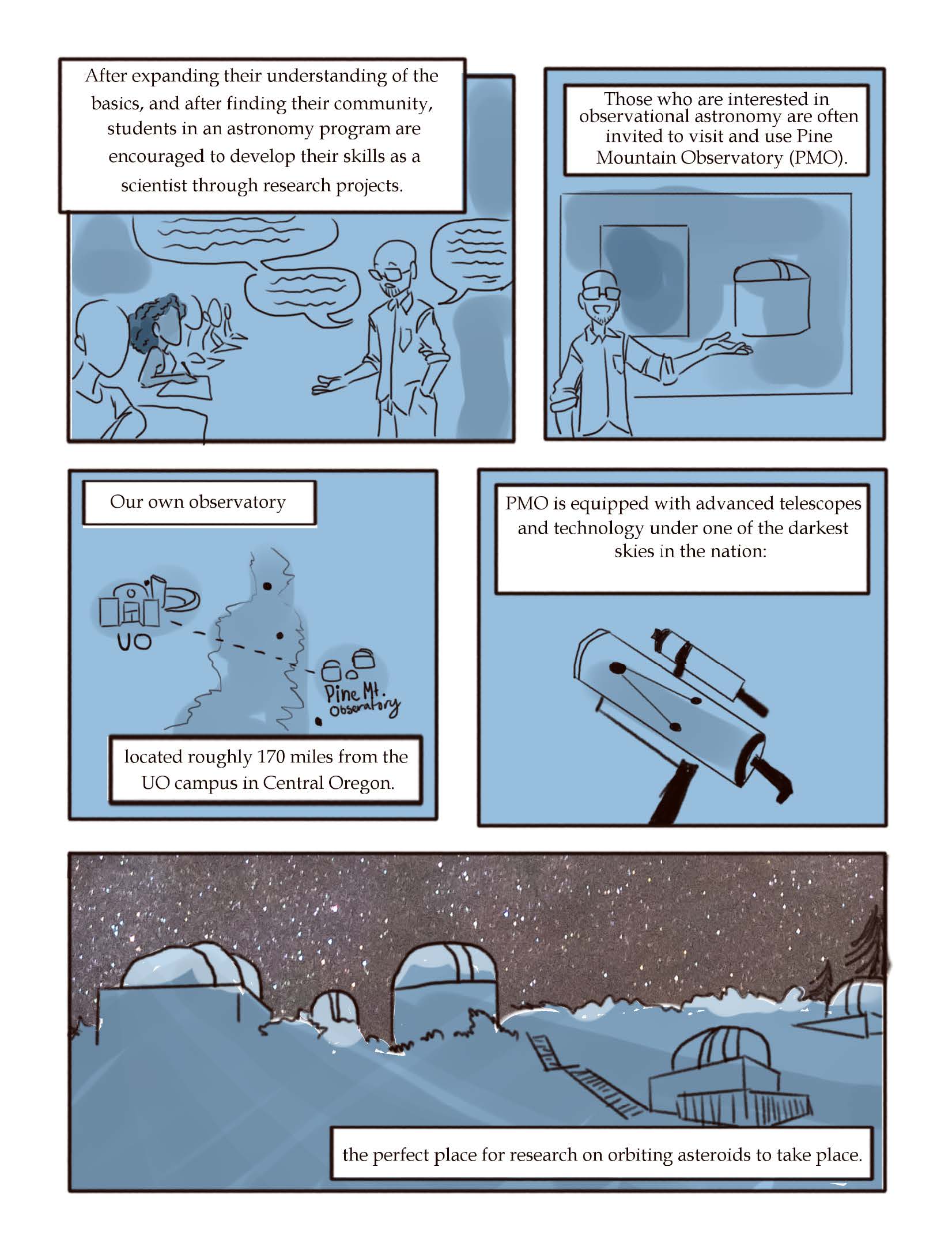
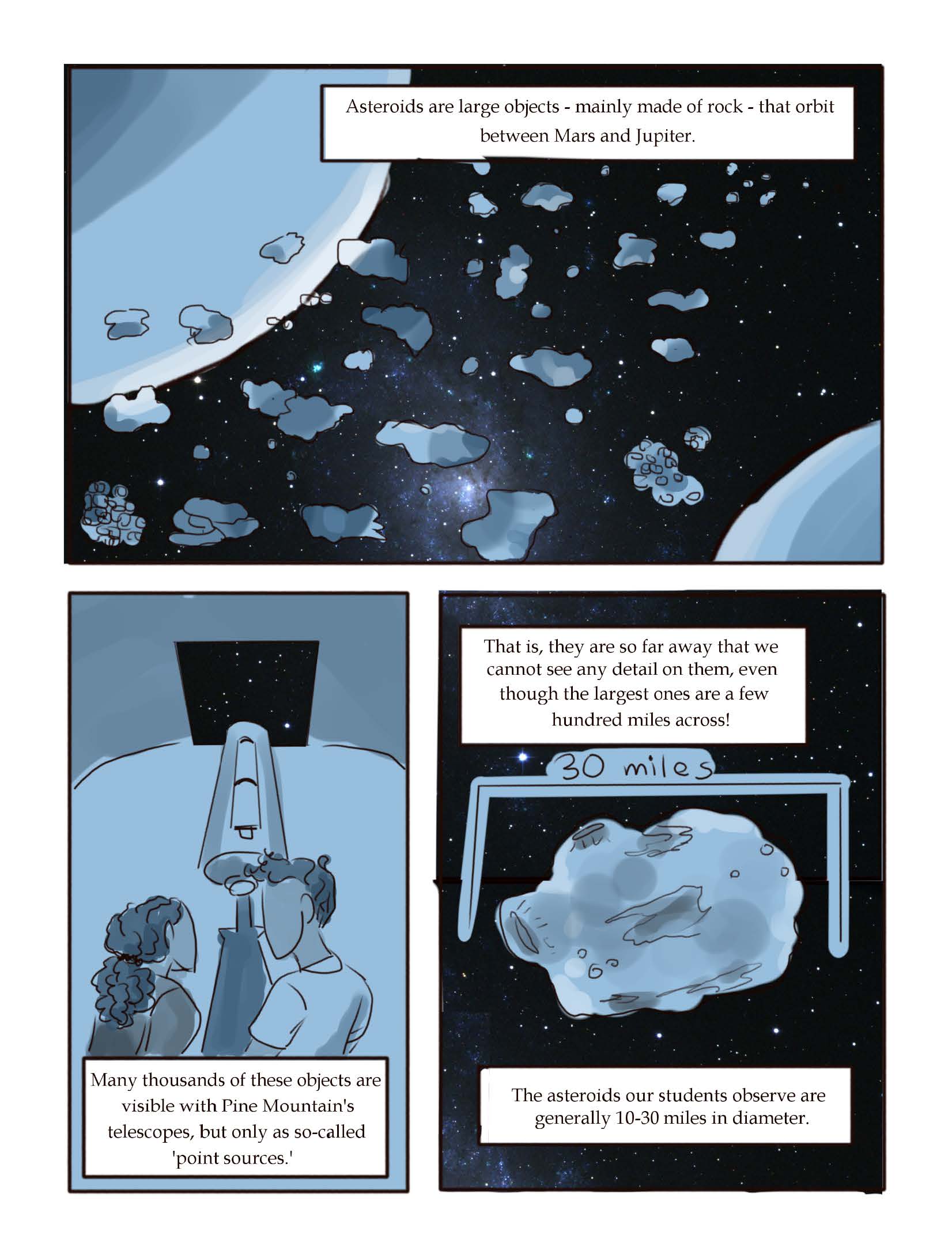
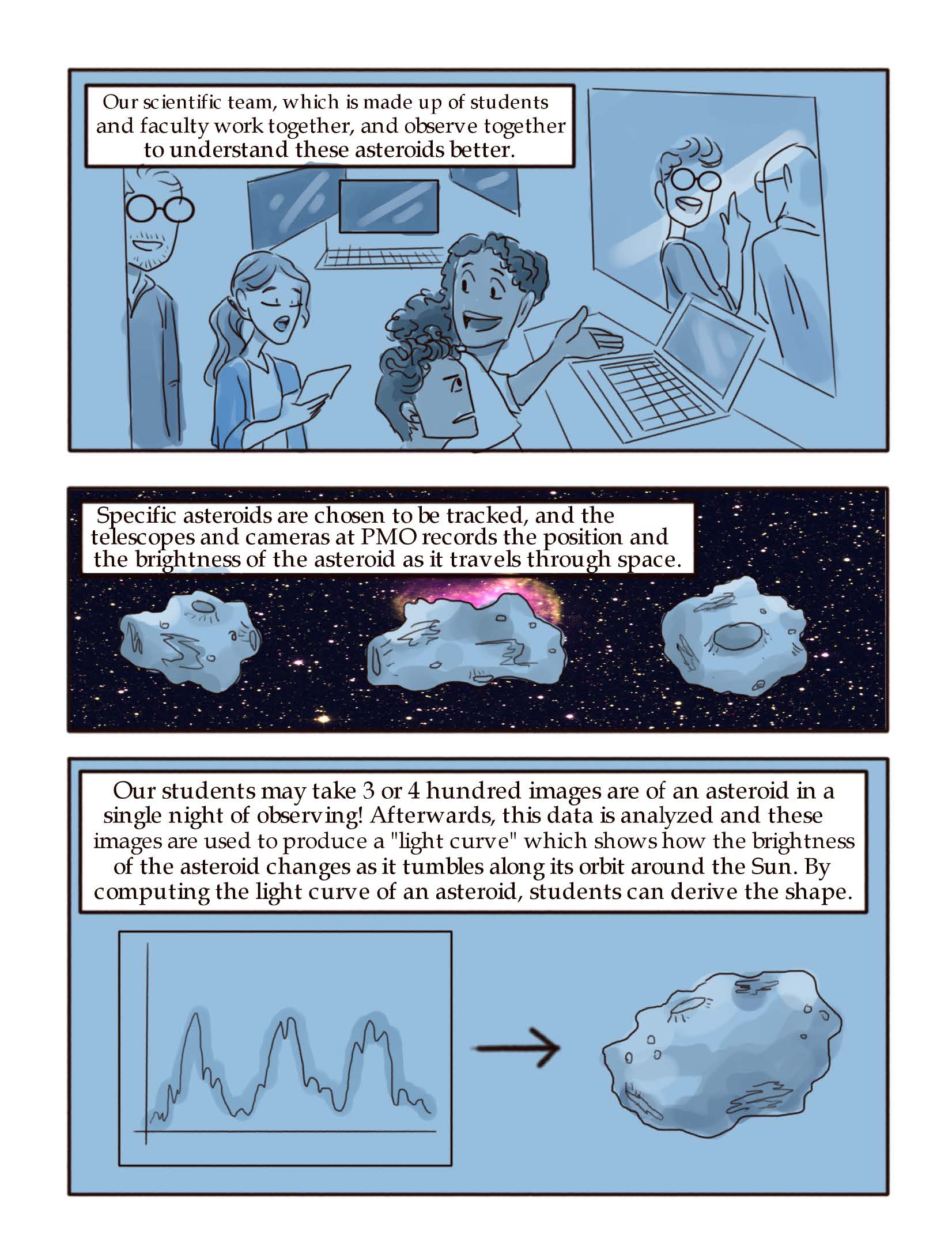
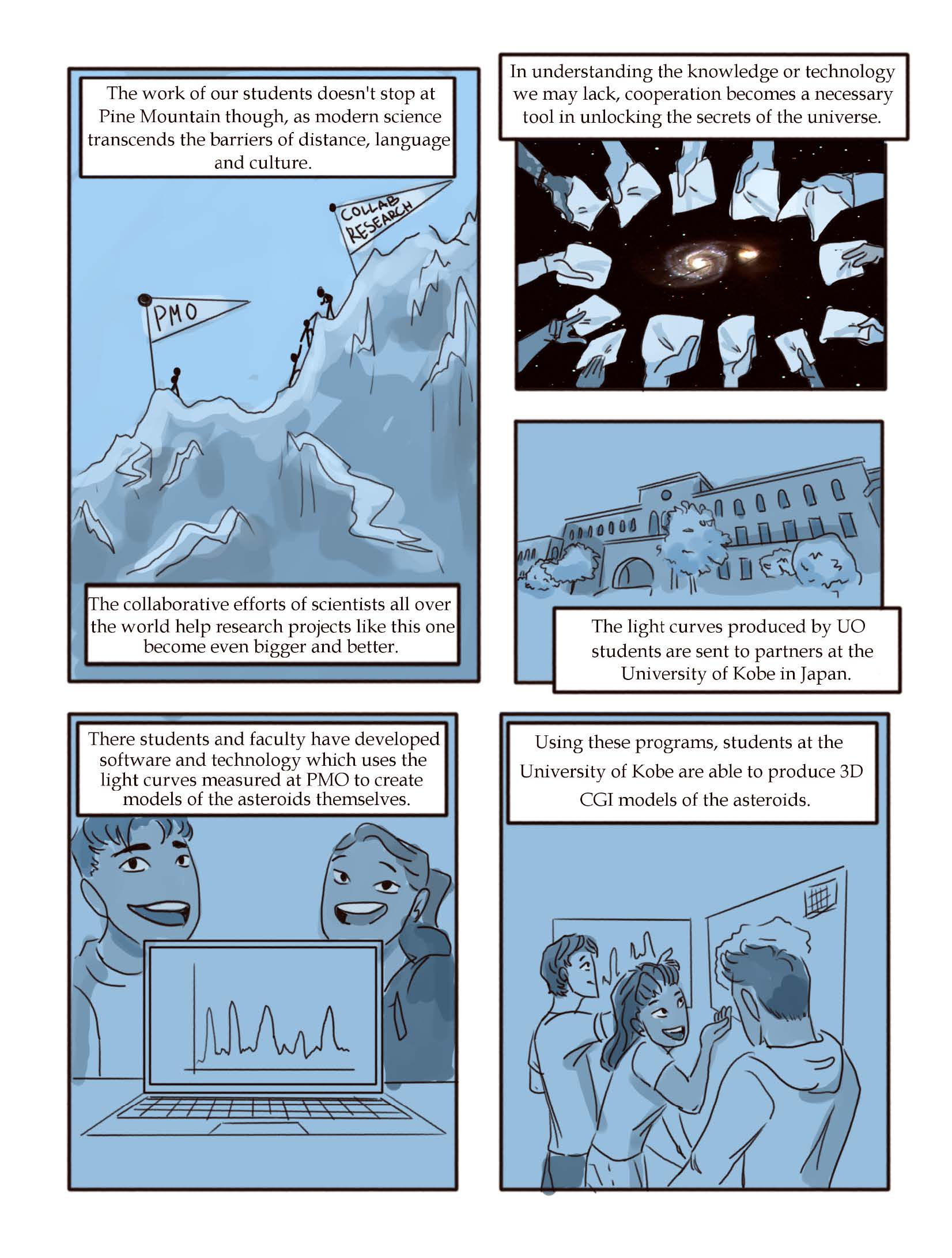
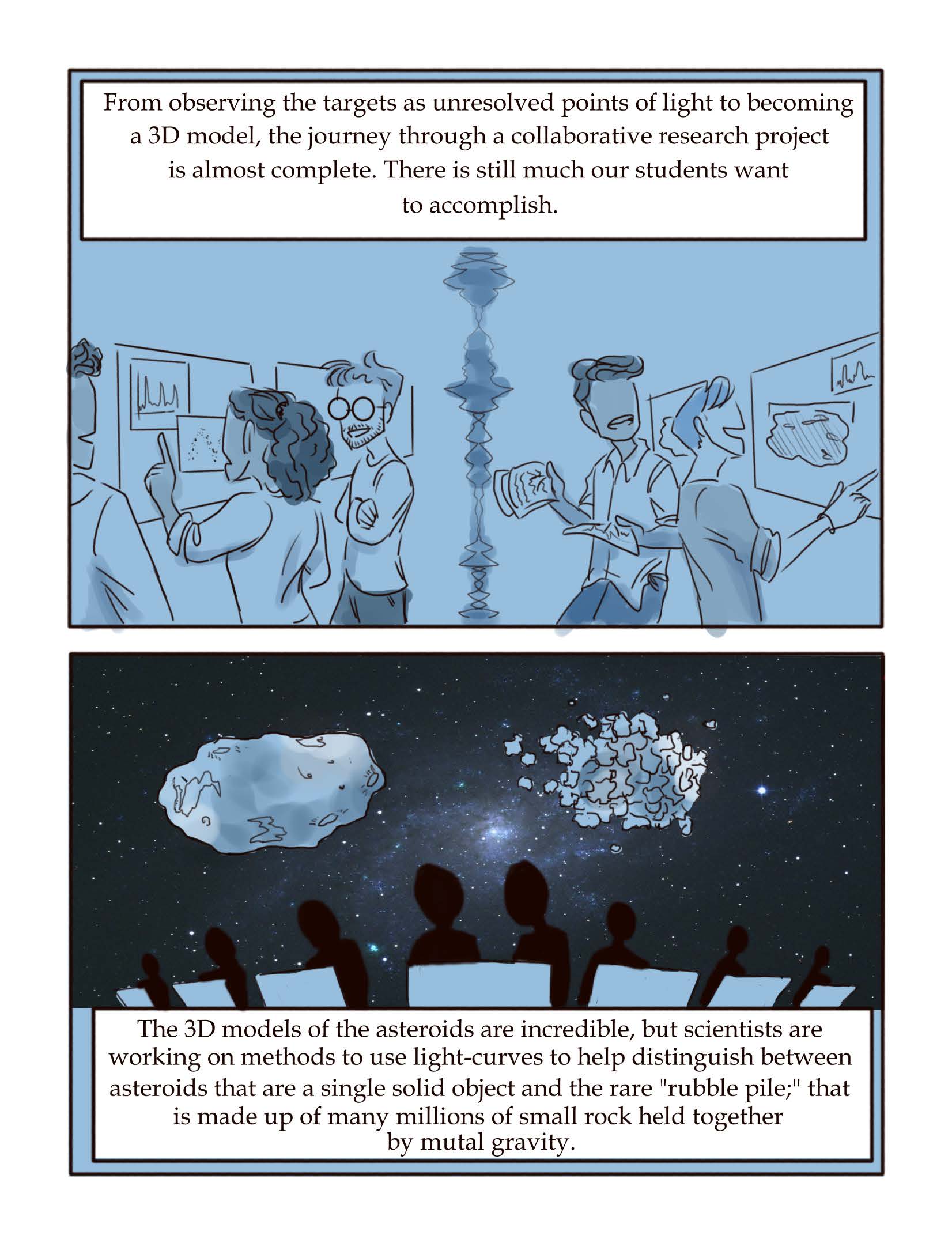
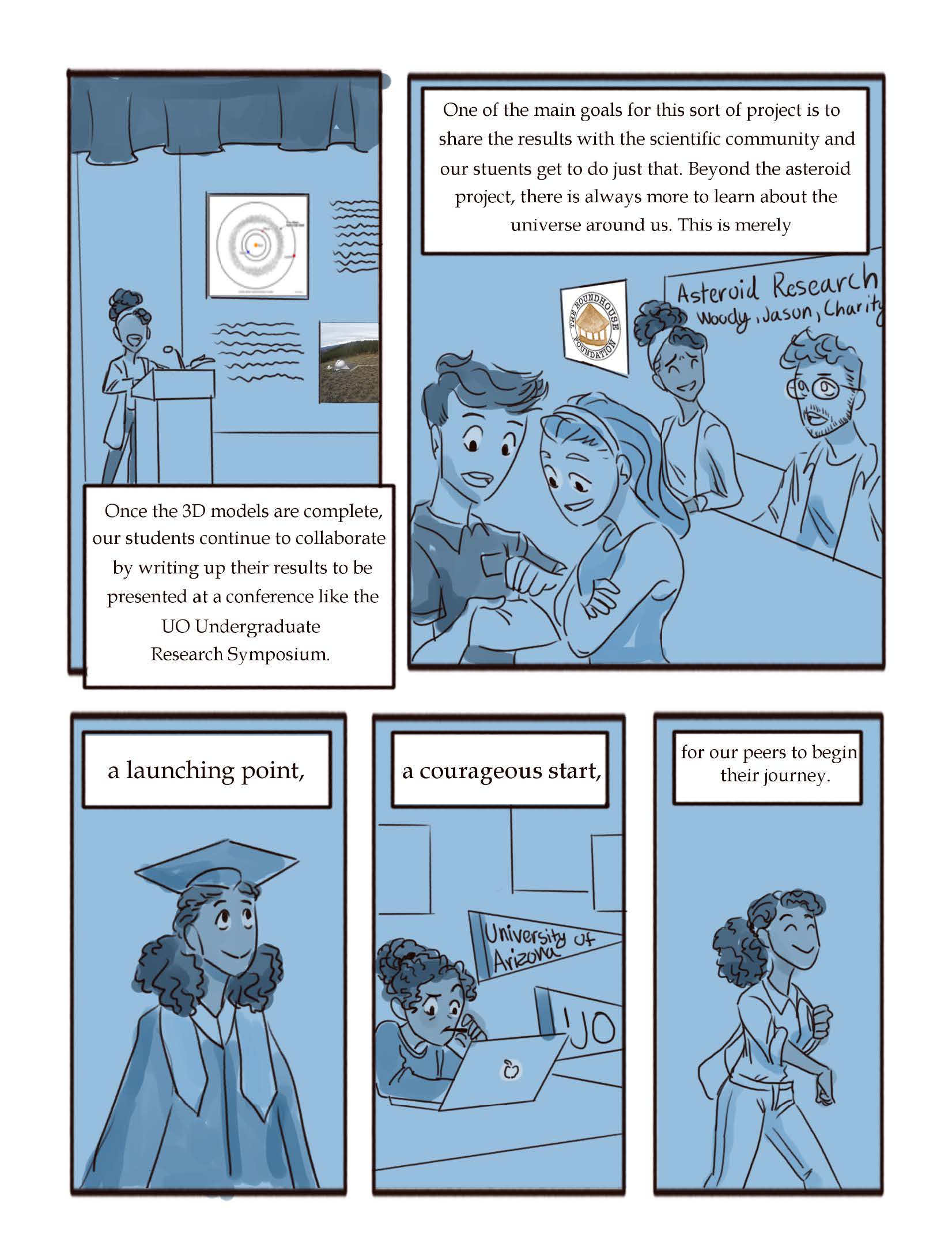
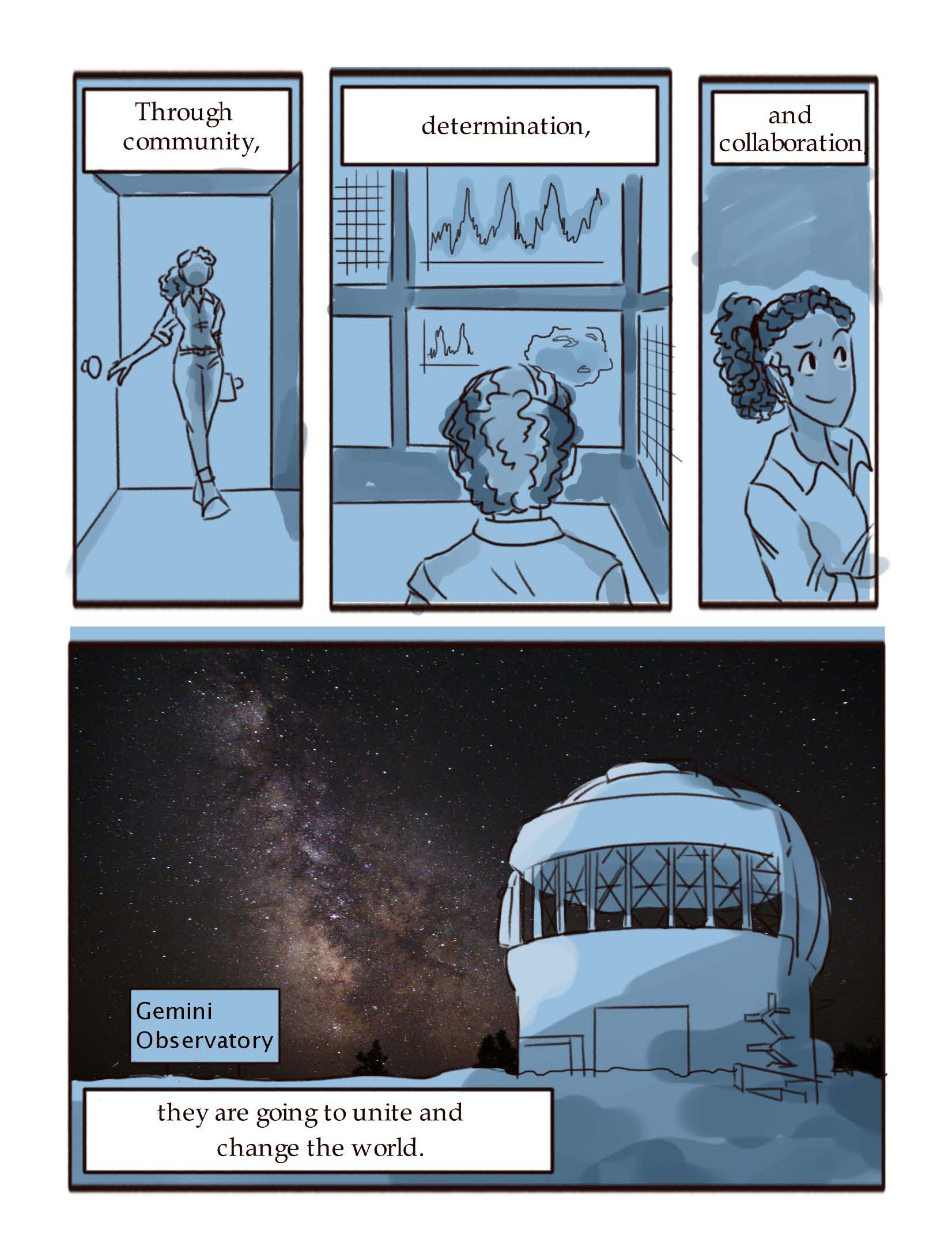
Transcript
Overview
A digitally drawn comic in a limited blue and grey color palette. The only panels that don’t use this color palette are panels that show space and the night sky, which use deep black and pinks and oranges to represent stars, nebulas, and galaxies. This color palette shift creates contrast with the rest of the comic, highlighting the novelty and importance of space. All of the text in the comic is narration by a single unknown narrator.
Cover
From Space, To Earth, And Back Again
Collaboration by Dr. Scott Fisher and Isabel Lopez
University of Oregon
Cover Description: The background is a view of space, with stars and a foggy orange and purple nebula. There is a small, cratered asteroid floating in the center of the page.
Page 1
Panel 1: “In addition to the intellectual opportunities and the social experiences, college is a time for young adults to explore their futures and how they’re going to leave their mark on the world.” A front view of University of Oregon’s Lillis Hall, a large building with a partially glass facade and a large Oregon ‘O’ above the door.
Panel 2: “Everyone has different passions and skill sets.” In the background students walk around campus. In the foreground a young woman with curly hair looks at the campus buildings and other students.
Panel 3: “So college offers the resources and guidance students need to find their path.” The young woman stares up at campus. Behind her a young couple walks across campus and students sit under a tree in the background.
Panel 4: “Some walk into their classrooms knowing…” The young woman walks through a hallway with purpose.
Panel 5: “their trajectory, and some hope to find…” The young woman sits at a desk, triangular emanata around her head representing her surprise and delight.
Panel 6: “their spark along the way.” A pink and purple nebula in a starry sky.
Page 2
Panel 1: “Maybe it is astronomy and the study of the universe which calls out to them. At UO, the physics department encourages students to pursue scientific advancement…” The young woman stands, mouth partially open, listening to a swarm of text bubbles full of unintelligible text.
Panel 2: “through undergraduate level research projects.” She talks to a bald professor wearing glasses and sitting at a desk.
Panel 3: “Every scientist starts off as a beginner, and every astronomer starts with a basic observing instrument: their eyes.” The young woman stands with 3 other students as the professor shows them a small telescope.
Panel 4: A close-up on the young woman’s eyes looking up.
Panel 5: She leans down to look through the telescope as the professor and another student watch.
Panel 6: “They also begin their astro-careers as the rare solo-astronomer as they could connections…” The young woman is excited, smiling widely as she looks up from the telescope.
Panel 7: The student behind her chuckles and her cheeks flush, “which will benefit them throughout…”
Panel 8: “their college careers.” The young woman and the other student high five.
Page 3
Panel 1: “Especially in the realm of astronomy study, the classroom is not a place of division; in fact, the astronomy community is open to a wide spectrum of people” Four students, including the young woman, hold clipboards and laugh together.
Panel 2: “And it invites all to participate and utilize their skills.” Two silhouetted figures sit at computers while two other people behind them point at charts on a projector screen.
Panel 3: “Whether a STEM major or a Liberal Arts major, whether an undergraduate or graduate, in astronomy, (and in science in general) students will find a community in which they can…” An overhead view of a human brain.
Panel 4: “grow,” the same four students sit at a table, working on their laptops.
Panel 5: “learn,” the students sit together in class.
Panel 6: “and live with each other.” The students stand together eating sandwiches.
Page 4
Panel 1: “After expanding their understanding of the basics, and after finding their community, students in an astronomy program are encouraged to develop their skills as a scientist through research projects.” The professor talks to a class.
Panel 2: “Those who are interested in observational astronomy are often invited to visit and use Pine Mountain Observatory (PMO).” The professor gestures to a projector screen showing the main observatory building, a small structure with a domed roof.
Panel 3: “Our own observatory located roughly 170 miles from the UO campus in Central Oregon.” A map shows UO and a route to Pine Mt. Observatory.
Panel 4: “PMO is equipped with advanced telescopes and technology under one of the darkest skies in the nation:” The observatory’s main telescope, similar to the one the young woman has used before but many times larger in size.
Panel 5: “the perfect place for research on orbiting asteroids to take place.” A large panel showing the observatory. There are several small buildings with domed roofs and windows in strips along the center of the roofs. Paths connect the buildings. The sky behind the landscape is dark and full of stars.
Page 5
Panel 1: “Asteroids are large objects – mainly made of rock – that orbit between Mars and Jupiter.” many asteroids float between two planets.
Panel 2: The young woman and one of her friends stand in front of the main telescope in the observatory. “Many thousands of these objects are visible with Pine Mountain’s telescopes, but only as so-called ‘point sources.’
Panel 3: “That is, they are so far away that we cannot see any detail on them, even though the largest ones are a few hundred miles across! The asteroids our students observe are generally 10-30 miles in diameter.” Against the background of space is a cratered oblong asteroid labeled 30 miles across on the long side.
Page 6
Panel 1: “Our scientific team, which is made up of students and faculty work together, and observe together to understand these asteroids better.” The same four students along with other students and faculty talk as they look at computers and tablets.
Panel 2: “Specific asteroids are chosen to be tracked, and the telescopes and cameras at PMO records the position and the brightness of the asteroid as it travels through space.” Three asteroids that are different oblong sizes and shapes float in space.
Panel 3: “Our students may take 3 or 4 hundred images of an asteroid in a single night of observing! Afterwards, this data is analyzed and these images are used to produce a ‘light curve’ which shows how the brightness of the asteroid changes as it tumbles along its orbit around the Sun. By computing the light curve of an asteroid, students can derive the shape.” A line graph with three distinct peaks. An arrow points from the graph to an asteroid.
Page 7
Panel 1: “The work of our students doesn’t stop at Pine Mountain though, as modern science transcends the barriers of distance, language and culture. The collaborative efforts of scientists all over the world help research projects like this one become even bigger and better.” Four figures climb a steep mountain. A flag at a lower peak reads “PMO.” The figures are climbing toward a flag further up the mountain that reads “collab research”.
Panel 2: “In understand the knowledge or technology we may lack, cooperation becomes a necessary tool in unlocking the secrets of the universe.” Thirteen hands of different sizes and skin colors, each holding a piece of paper, form a circle reaching into the center. The hands are superimposed over a background of space with a galaxy in the middle of the circle.
Panel 3: “The light curves produced by UO students are sent to partners at the University of Kobe in Japan.” The facade of a 3-story building with well-manicured trees in front of it.
Panel 4: “There students and faculty have developed software and technology which uses the light curves measured at PMO to create models of the asteroids themselves.” Two Japanese students present a laptop showing a line graph with distinct peaks.
Panel 5: “Using these programs, students at the University of Kobe are able to produce 3D CGI models of the asteroids.” Three Japanese students look at charts and graphs on the walls.
Page 8
Panel 1: “From observing the targets as unresolved points of light to becoming a 3D model, the journey through a collaborative research project is almost complete. There is still much our students want to accomplish.” One the left side of the panel, students including the young woman and her friends discuss line graphs pinned to the walls of a classroom while on the right side of the panel students point towards images of 3D models of asteroids.
Panel 2: “The 3D models of the asteroids are incredible, but scientists are working on methods to use light-curves to help distinguish between asteroids that are a single solid object and the rare “rubble pile;” that is made up of many millions of small rocks held together by mutual gravity.” Against the background of space float an asteroid and a collection of smaller rocks and rubble forming an asteroid-like shape. In the foreground silhouetted researchers stare at laptop screens, contemplating data.
Page 9
Panel 1: “Once the 3D models are complete, our students continue to collaborate by writing up their results to be presented at a conference like the UO Undergraduate Research Symposium.” The young woman is wearing a lab coat as she stands on a stage behind a podium. Behind her is a slide showing scientific research.
Panel 2: “One of the main goals for this sort of project is to share the results with the scientific community and our students get to do just that. Beyond the asteroid project, there is always more to learn about the universe around us. This is merely…” The four students sit and talk. Behind them is a large sign with the text “Asteroid Research: Woody, Jason, Charity…” and the logo of the Roundhouse Foundation.
Panel 3: “a launching point,” The young woman is wearing a graduation gown and cap.
Panel 4: “a courageous start,” She looks intently at her laptop screen, behind her are pennant flags for the University of Arizona and UO.
Panel 5: “for our peers to begin their journey.” She walks forward confidently with a smile.
Page 10
Panel 1: “Through community,” She opens a door and walks through it carrying a clipboard.
Panel 2: “determination,” She looks at walls full of charts and line graphs showing asteroid light curves.
Panel 3: “and collaboration” A close-up on her face as she looks determined and excited.
Panel 4: “they are going to unite and change the world.” A large panel labeled the Gemini Observatory shows a domed building with large glass windows around the circumference against the backdrop of a starry sky.

